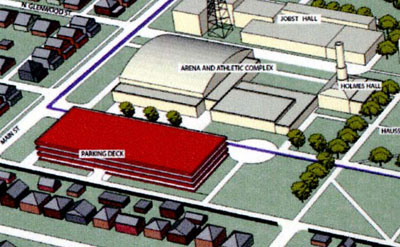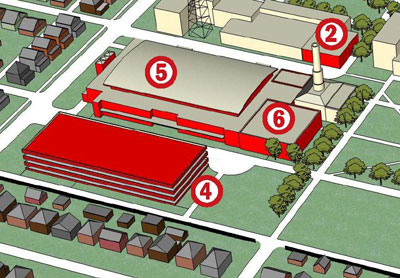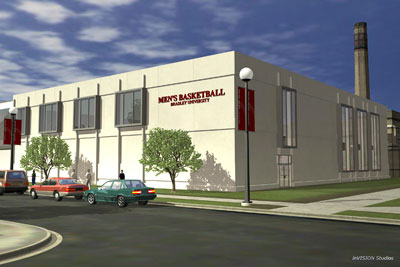Bradley University submitted its new institutional plan to the City on Thursday (1/25). Since I was downtown yesterday for a meeting anyway, I stopped by the Planning & Growth department to take a look at it. It’s a comb-bound collection of mostly artistic renderings of the physical changes the University wants to make to their campus. I was able to get a copy of their introduction and key elements — the only textual part of the plan — but the illustrations will have to wait until they’re released in PDF format because they’re too large and detailed to photocopy well. (Here’s a copy of the Introduction and Key Elements in PDF format.)
An open meeting has been scheduled for the public to review and discuss Bradley’s expansion plans Monday, February 5, at 6:00 p.m. in the Marty Theater (lower level of the Michel Center).
There are just a few observations I’d like to make after my initial view of the plan.
First, the university states their reasons for expansion in their introduction thus:
This plan represents a 10-15 year view of proposed physical changes to Bradley University’s campus facilities. These proposed changes evidence the university’s commitment to maintaining and improving its competitiveness in the upper echelon set of universities in the region and the country. These changes are not intended to facilitate undergraduate enrollment growth; the university does not have plans to grow its undergraduate enrollments or curriculum. Rather, Bradley’s services and programs require improved infrastructure support.
This was a little surprising to me because I was somehow under the impression that they were trying to grow enrollment-wise. It turns out that they are just wanting to upgrade their infrastructure to provide better facilities for their current enrollment levels and stay more competitive with similar universities.
Under their “Key Elements of the Plan” section, they have this to say about the arena they are planning to replace Robertson Memorial Fieldhouse:
It is believed that both this facility and the parking facility have been designed with consideration for New Urbanism architectural concepts given their proximity to Main St.
I would be interested to hear more about this particular aspect. To my knowledge, the Heart of Peoria Commission has never looked at or been asked to look at Bradley’s plans or comment on how well they conform to the principles of New Urbanism or the Heart of Peoria Plan. But I’ve only been on the Commission a short time, so I’ll have to check on that.
That said, they are correct that by building the proposed arena up to the sidewalk along Main street, they are in that sense following the principles of New Urbanism. They’ve also chosen to use pre-cast concrete made to look like limestone as their building façade for both the arena and the parking deck so they will blend with the existing architecture. This is durable and reflects a sense of permanence, which is desired in an urban environment. And while there’s only so much one can do with a parking deck, they’ve tried to make it look as nice and blended with surrounding architecture as possible.
However, a five-story parking deck right across the alley from single-family homes is not exactly the kind of form that’s desired in New Urbanism or in form-based coding. Setting aside the reasons for its location for a moment, a structure of that size would be better placed further into the campus’s interior or, if placed on the perimeter, it would be better placed along an arterial road like University where it fits better with the surrounding commercial context.
But, of course, the purpose of the parking deck is to provide parking primarily for the arena, recreational center, and new student housing, so it needs to be close to those structures. I think it would be better placed between the arena and recreational center on the east side of Maplewood behind (or possibly around) Morgan Hall. Right now that is designed to be another quad to the rear of Bradley Hall. Moving the parking deck there would make it equidistant from the three structures it’s primarily designed to serve and would keep it further away from the Arbor District. It would also relieve the necessity of razing all the houses on Maplewood — only those that need to be removed to make space for the new student housing would need to be torn down.
My last observation is about this part of their plan:
With the proposed campus changes, vacation of both Maplewood Ave. and Glenwood Ave. from Bradley Ave. to Main St. is requested.
The reason they want to vacate these streets and have the university take over maintenance of them is so they can terminate them at the newly-envisioned quad behind Bradley Hall. Essentially these two through-streets would become four dead-end streets. This is possibly my biggest concern about their plan. This will significantly limit the ability to get around and through Bradley’s campus and put more strain on the other streets.
If Glenwood and Maplewood are terminated, the only street that passes completely through campus will be Elmwood. Elmwood, while still a through-street, is essentially the university’s front parking lot. Through traffic will be more likely to use University to the east of campus or Cooper/Rebecca to the west of campus, meaning in the latter case that more traffic will be funneled through the Arbor District. More traffic on University means that an already busy street will get even busier, making it that much more unfriendly to pedestrians.
The next step is for the Zoning Committee to review the plan over the next few weeks and then make a recommendation to the City Council, which will make the final decision on approval.





 Bradley University first filed an Official Development Plan (ODP) in 1991 when the city created the N1 (Institutional) zoning designation. Since then, it has been amended four times, expanding their institutional boundaries each time, but the balance of the plan is still in effect. The largest addition was the St. James apartments east of campus.
Bradley University first filed an Official Development Plan (ODP) in 1991 when the city created the N1 (Institutional) zoning designation. Since then, it has been amended four times, expanding their institutional boundaries each time, but the balance of the plan is still in effect. The largest addition was the St. James apartments east of campus.